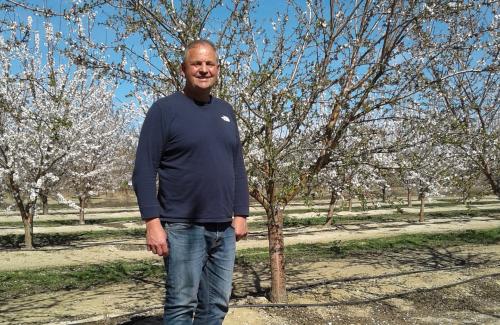
Farm Information
County: Colusa
Location: Near the Sacramento River
Slope: Flat
Irrigation system: Drip
Soil type: Heavy clay, clay loam
Soil detail: Heavy clay, clay loam
Special farming challenges: Heavy soil
- Cropping Systems Information
- Crop: almonds
Acres of orchard or vineyard: 350Other crops: Pecans
Acres of other crops: 265
Organic management: No
Certifications: None
Certifications notes: Goal is to get bee friendly farming certification
Where using cover crops: Almonds, pecans - Grower Experience, Farm Priorities, and Cover Cropping Goals
- When started farming (yr): Family farming in the area since 1860. He established Pacific Gold Agriculture 2014
Farm priorities: To create a sustainable, diversified farm-to-fork tree nut enterprise, trace and differentiate the crop to have consumer affinity around sustainability. Seek out investors who care about sustainability and scale sustainable practices over time, over several decades.
Years growing orchard or vineyard crop: 5 years
Years growing cover crops: 5 years
Initial transition to cover cropping: First planted 180 acres, now on whole 350 acres. Working with the ApisM program. Started with mustard, radish, bell bean, wheat mix
Goals and benefits: Soil improvement, water infiltration/retention, pollinator support, insect predator support
Benefits description: “How it affects soil structure and water penetration. Ground that has had cover crops, you can look at it after rainfall and see much less runoff than ground without cover crop.” "We definitely see beneficial insects enjoying the habitat as well as many mammal and bird species." Also reduced soil cracking late in the season - nuts get lost in the cracks. Better water percolation when it rains.
Change in goals over time: After initial focus on pollinator habitat, now also sees how cover crops are good for improving soil structure and water infiltration
Reasons: Began to see how useful cover crops were for soil structure - reducing large cracks and improving water infiltration, so now going for more of a soil builder mix. It's also more economical and effective during dry years. Also, it got disappointing to try to achieve a mustard bloom at the same time as almond bloom. During some years, the mustard blooms after the almonds and the bees are already gone. So started focusing more on just getting a good cover crop established in the fall, without trying to synchronize bloom time. - Cover Crop Details, Planting and Management Methods
-
Block described here: Almonds
Current cover crops: Legumes, grasses, brassicas
Species and mixes: Project ApisM soil builder mix: 30% Triticale, 35% Bell beans, 28% Peas, 2% Canola, 2% Common yellow mustard, 3% Daikon Radish
Planting method: Drill seed
Planting date (2020): initial planting in Mid-Oct to early Nov every other row; then in Jan came back and seeded remaining rows due to time shortage in fall
Was that optimal? Optimal time is as soon after harvest as possible - early October if aiming for bloom to synchronize with almond bloom. Need warm enough temperatures for good germination and establishment, but also need rain, otherwise seed becomes bird food. The cover crop got to 2-3 ft height where it was planted early.
Pre-plant soil prep: n/a
Planting equipment: Grain drill
Seeding rate: n/a
Seeding depth: 1/4 inch
Did it germinate well? Slow - currently (in early Feb) just a few inches, just getting good growth from the recent storm. Would like to see close to bloom by now, close to budding.
Additional management and advice: They try to let the cover crop grow as much as possibly can. If they need to spray trees and cover crop is too tall and would get caught in radiators of tractors or fans of spraying. - Cover Crop Termination Methods and Biomass Management
-
Termination method: Mow
Termination equipment and process: Flail mower - scalping, cutting as close to the ground as possible, within 2 inches. In areas where the plant material is very thick, lift the mower several inches to progress through. In these areas, the operator will raise the mower after cutting the heavy area, reverse the machine, drop the mower all the way down, and mow again to get as close as possible to the ground. Let mowed material dry out for a few days then mow again to make pieces as small as possible so they break down by harvest.
Termination date: late April
Was it optimal? For mustard mix - terminate when it starts getting woody and pods develop. Last year some of the cover seemed to get out of hand because it was growing so much so late in the season.
Biomass management: Let the mowed material dry out. After drying mow again to make the biomass as small as possible. This additional mowing is done to breakdown biomass material so harvest operations aren't impacted. - Cover Cropping Challenges and Strategies to Address Them
- Challenges: Orchard floor residue at harvest, risk of frost, vertebrate pests
Challenges description: Residue on orchard floor at harvest, risk of frost damage, gophers and rabbits in heavy stands
Strategies to address challenges: Mow multiple times so that the orchard floor is pretty bare by harvest time. Organic material going to huller was very low - not a problem. For rabbits and gophers - Keep borders clean of weeds and cover crops, use herbicide on borders where drip line is.
Was the cover crop worth it? Even if you have only 2 inches of water, that’s 2 inches going into your soil instead of running off. That’s 2 inches you don’t need to pay for. At $200/acre water cost – that’s enough to pay for the cover crop. On the issue of the cover crop using up water, if the water doesn’t go into the soil (because it’s running off) then you’re losing it, too. It’s not a problem. Thinks that research shows net positive Et benefit to cover crops. Also, photosynthesis requires water, so for carbon capture, you want to capture natural rainfall. The trees are dormant during the rains, but the cover crop can use water for photosynthesis.
Least successful past cover crops: n/a
